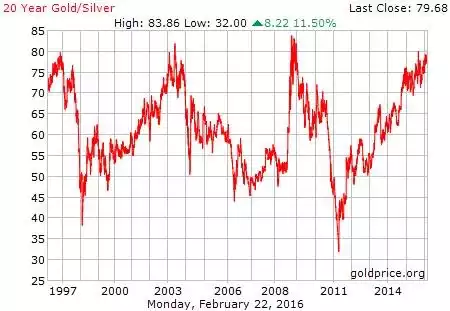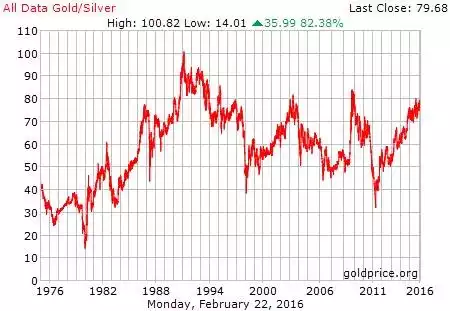Gold:Silver Ratio Hits 83! – Mean Reversion?
News
|
Posted 29/02/2016
|
8821
It’s the perennial question – gold or silver? Well if you didn’t notice, the GSR (gold:silver price ratio) just hit 83, only a smidge off a 20 year high. Why is that significant? Well few things in life are certain, but one that essentially is, is the mathematics rule of ‘mean reversion’.
A mean (average) is established by a variable number or index over time rising and falling, forming an average or mean around the middle of that range. We have reported numerous times before about the GSR being one such example. Whilst silver and gold generally track each other, the extent of that varies over time as silver is the more volatile of the two – it historically has lower lows and higher highs compared to gold. With a 100 year average sitting around the 45 figure and 83 being at a near historic high (check out the charts below), it is telling us silver is seeing its lower low about now-ish. Those who like to buy low and sell high may be taking particular interest about now.
To quantify this on today’s prices with gold at $1716 and silver at $20.65, if the gold price did not change one single cent but the GSR reverted to the mean of 45 you would see an 85% increase in your silver price. Sound good? Well that (by definition) is only half the story. That was just to the mean of 45. To establish that mean, history tells us it fluctuates equally either side of the mean. That would mean a GSR of roughly 10, or silver at $172/oz after a 731% increase, again without gold moving a single cent.
This is a macro trend and can’t be applied to the immediate future. Silver is arguably dragged down now because it is half commodity and all commodities are in the gutter. But with patience and logical thought application it looks very compelling as a buy right now.
Let us leave you with this too – the GSR is 83 yet silver is mined about only 9 times more than gold, they estimate the in ground ratio is only about 16 times and that there is only about 4.5 times in above ground inventory. Half of it is used in industry in products that are largely discarded after use (i.e. no recovery). Does any of that justify 83???

